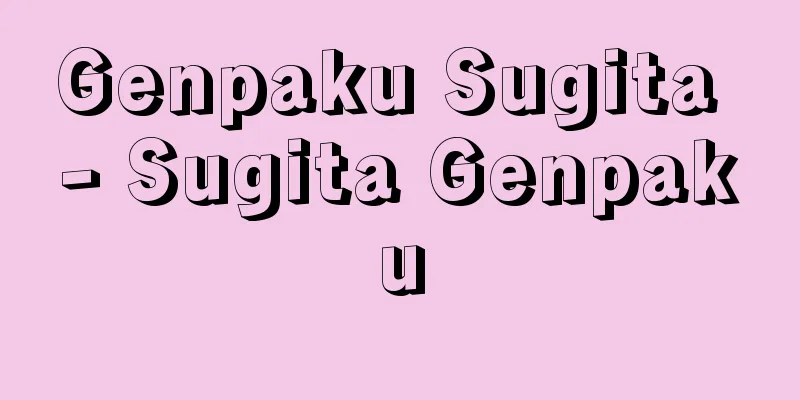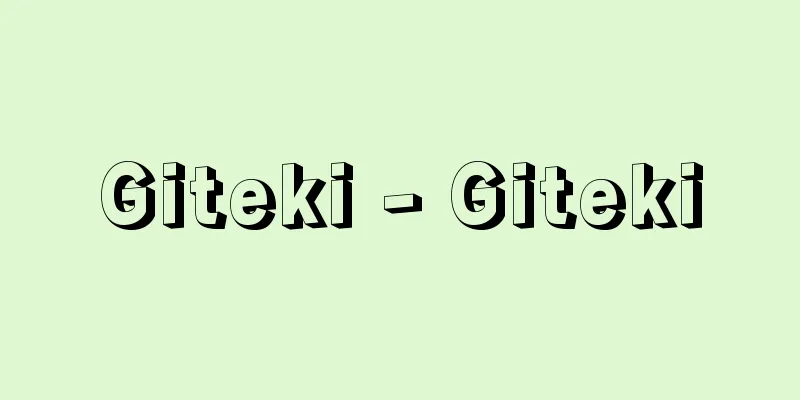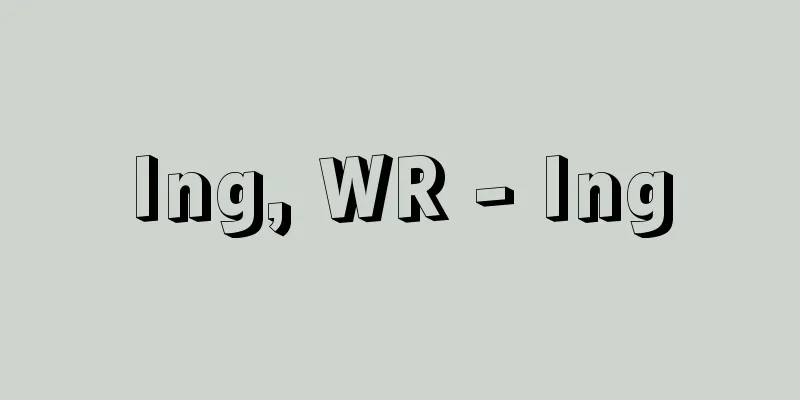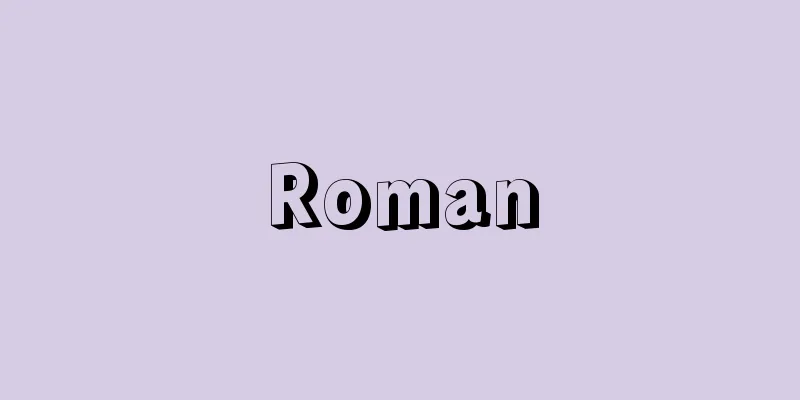Genpaku Sugita - Sugita Genpaku

|
A doctor and scholar of Western medicine in the mid-Edo period. His given name was Yoku, his pen name was Shiho, and he was known as Kyuko after his name Isai, and Genpaku was his nickname. He studied at Tenshinro, and in his later years, he lived in a villa called Shoshisendo. He was born in the middle mansion of the Obama domain in Edo to Lord Sakai, physician Sugita Hosen (1692-1769), in Wakasa Province (now Fukui Prefecture). He lost his mother during a difficult birth. He studied Chinese classics under Miyase Ryumon (1720-1771) and Western surgery under the shogunate physician Nishi Gentetsu (1681-1760), and became a physician for the domain. Through the domain's physician Kosugi Genteki, he was inspired by the preaching of ancient medical methods by Yamawaki Toyo, and met the head of the Dutch trading post in the Edo court and Dutch interpreter Yoshio Kogyu (Kozaemon), among others, and asked them about Dutch surgery, eventually obtaining a copy of the Dutch medical book "Tabulae Anatomie." In the spring of 1771 (Meiwa 8), he observed an autopsy on the body of a death row inmate at the execution grounds of Kozukahara in Edo with Maeno Ryotaku and Nakagawa Junan. As a result, he learned of the intricacy of the Tabulae Anatomicae (or, more accurately, Ontleedkundige Tafelen (Atlases of Anatomy) written by the German anatomist Krums and translated into Dutch by the Dutchman Gerardus Dicten (c. 1696-1770), and decided to translate it together with his comrades, which he began work on. After four years of hard work, in 1774 (An'ei 3), he completed five volumes of Kaitai Shinsho (New Book of Anatomy) (one volume of illustrations and four volumes of illustrations), which became the driving force behind its publication. This was the beginning of a full-scale translation project of Western medical books in Edo, and had an enormous impact on the history of medicine in Japan, making a great contribution to the subsequent development of Dutch studies. The efforts of his comrades in the translation are described in detail in his later memoirs, The Beginnings of Dutch Studies. In his spare time from working for his master's family, treating many patients and visiting sick families, he ran the Tenshinro school and worked to train many students, including Otsuki Gentaku, Sugita Hakugen, and Udagawa Genshin (1770-1835). He also devoted himself to collecting Dutch books and made them available to his students, thereby contributing to the development of Dutch studies. In addition to the translations mentioned above, he enlightened people about medical knowledge in such works as "Dutch Medical Questions and Answers" (1795), a collection of letters between him and Takebe Seian, a physician of the Ichinoseki domain in Oshu, "Anatomy Guidelines" (1773), "Words of a Mad Doctor" (1773), "Evening Talks on Shadows" (1810), and "Seven Must-Keep Items for Health Care." He also discussed political and social issues and expressed his beliefs in many works, including "Twenty-Four Articles on Madness," "Guidelines for Guardians" (1787), "Tamamiso," "Yasou Dokugo" (1807), "Kenkaicho" (Discourse on Dogs), and "Botetsu Dokugo." From his diary, "Osai Nikki," we can see how he regularly held a study group called "Byoronkai" (Symposium on Diseases) at a venue rotated among the members, and how he devoted himself to medical research. In his youth, he learned Renga (linked verse) from Saka Shoshu (?-1784) and composed his own poetry. He also had connections with Edo Western-style painters such as So Shiseki and Ishikawa Tairo (1765-1818), and his artistic skills were also highly developed, as can be seen from his caricatures, such as the large, vividly colored "One Hundred Cranes." In pursuit of the essence of Western medicine, he engaged in heart-to-heart dialogue with Takebe Seian, and adopted the fifth son of his partner, Takebe Seian, who renamed him Hakugen and had him take over the family school. His own son Ryukei established a separate branch of Western-style ophthalmology, and among his descendants were such accomplished Western scholars and physicians as Seikei and Gentan, who are still active today. A portrait painted by Ishikawa Tairan gives a good impression of Genpaku in his old age. He died of an illness in Edo on April 17, 1811, at the age of 85. His grave is located at Eikan-in (commonly known as Saru-dera), a subtemple of Tendoku-ji Temple in Toranomon, Minato-ku, Tokyo, and is designated a Tokyo historic site. [Kazuo Katagiri, May 19, 2016] "Sugita Genpaku" by Kazuo Katagiri (1971/New edition, 1986, Yoshikawa Kobunkan) [References] | Japanese | | | | | | | | | | |Written by Krums, translated by Sugita Genpaku, Maeno Ryotaku, Nakagawa Junan, and Katsuragawa Hoshu, illustrated by Odano Naotake, published in 1774 (An'ei 3), held at the National Diet Library . "Anatomy New Book" Source: Shogakukan Encyclopedia Nipponica About Encyclopedia Nipponica Information | Legend |
|
江戸中期の蘭方医(らんぽうい)、蘭学者。名は翼(よく)、字(あざな)は子鳳、鷧斎(いさい)のち九幸(きゅうこう)と号し、玄白は通称。学塾を天真楼といい、晩年の別邸を小詩仙堂(しょうしせんどう)という。若狭(わかさ)国(福井県)の小浜(おばま)藩酒井侯の藩医杉田甫仙(ほせん)(1692―1769)の子として江戸の藩邸中屋敷に生まれ、難産であったため、そのとき母を失う。宮瀬竜門(りゅうもん)(1720―1771)に漢学を、幕府医官西玄哲(1681―1760)に蘭方外科を学び、藩医となる。同藩の医師小杉玄適を通じ、山脇東洋(やまわきとうよう)の古医方の唱導に刺激を受け、また江戸参府のオランダ商館長、オランダ通詞(つうじ)吉雄耕牛(よしおこうぎゅう)(幸左衛門)らに会い、蘭方外科につき質問し、やがてオランダ医書『ターヘル・アナトミア』を入手した。1771年(明和8)春、前野良沢(まえのりょうたく)、中川淳庵(なかがわじゅんあん)らと江戸の小塚原(こづかっぱら)の刑場で死刑囚の死体の解剖を実見した。その結果『ターヘル・アナトミア』、正しくはドイツの解剖学者クルムスが著し、オランダのディクテンGerardus Dicten(1696ころ―1770)のオランダ語訳した『Ontleedkundige Tafelen』(『解剖図譜』)の精緻(せいち)なるを知り、同志とともに翻訳を決意して着手する。4か年の努力を経て、1774年(安永3)『解体新書』5巻(図1巻・図説4巻)を完成し、刊行の推進力となった。この挙は江戸における本格的蘭方医書の翻訳事業の嚆矢(こうし)であって、日本の医学史上に及ぼした影響すこぶる大きく、その後の蘭学発達に果たした功績は大きい。彼ら同志の翻訳の苦心のありさまは晩年の追想『蘭学事始(ことはじめ)』に詳しい。主家への勤務をはじめ、多数の患者を診療し、患家を往診する余暇に、学塾天真楼を経営し、大槻玄沢(おおつきげんたく)、杉田伯元、宇田川玄真(1770―1835)ら多数の門人の育成に努めた。また蘭書の収集に意を注いで、それを門人の利用に供するなど蘭学の発達に貢献した。前記の訳著のほかに奥州一関(いちのせき)藩の医師建部清菴(たけべせいあん)との往復書簡集『和蘭(おらんだ)医事問答』(1795)をはじめ、『解体約図』(1773)『狂医之言』(1773)『形影夜話(けいえいやわ)』(1810)『養生七不可(ようじょうしちふか)』などにおいて医学知識を啓蒙(けいもう)し、『乱心二十四条』『後見草(あとみぐさ)』(1787成立)『玉味噌(たまみそ)』『野叟独語(やそうどくご)』(1807成立)『犬解嘲(けんかいちょう)』『耄耋(ぼうてつ)独語』など多くの著述を通じて、政治・社会問題を論述し、その所信を表明した。 彼の日記『鷧斎日録』をみると、「病論会」なる研究会を定期的に会員の回り持ち会場で開催して、医学研鑽(けんさん)に努めたようすをうかがうことができる。若いころに阪昌周(さかしょうしゅう)(?―1784)に連歌(れんが)を習って、自ら詩歌をつくり、宋紫石(そうしせき)、石川大浪(いしかわたいろう)(1765―1818)ら江戸の洋風画家たちとも交わって画技も高かったことは、その大幅で極彩色の「百鶴(ひゃっかく)の図」をはじめとして、戯画などを通じてうかがい知ることができる。 蘭方医学の本質を求めて、心の問答を展開した相手建部清菴の第5子を養子に迎え、伯元と改称せしめ家塾を継がせた。実子立卿(りゅうけい)には西洋流眼科をもって別家独立させ、その子孫には成卿(せいけい)・玄端(げんたん)ら有能な蘭学者・蘭方医が輩出、活躍している。石川大浪が描いた肖像は老境の玄白像をよく伝えている。文化(ぶんか)14年4月17日、江戸で病没、85歳。墓は東京都港区虎ノ門、天徳寺の塔頭(たっちゅう)、栄閑院(通称猿寺)にあり、東京都史跡に指定されている。 [片桐一男 2016年5月19日] 『片桐一男著『杉田玄白』(1971/新装版・1986・吉川弘文館)』 [参照項目] | | | | | | | | | | | |クルムス著 杉田玄白・前野良沢・中川淳庵・桂川甫周訳 小田野直武画 1774年(安永3)刊国立国会図書館所蔵"> 『解体新書』 出典 小学館 日本大百科全書(ニッポニカ)日本大百科全書(ニッポニカ)について 情報 | 凡例 |
>>: Scythian culture - Scythian culture
Recommend
Ekuru - Ekuru
⇒Ecru Source: About Shogakukan Digital Daijisen In...
Hafsid Dynasty - Ḥafṣ
An Islamic dynasty (1228-1574) in Tunisia, North A...
Netto, C.
...In 1880, this department was divided into the ...
Issei Maehara - Issei Maehara
A Choshu Domain sonno joi (sonjoi) patriot and po...
Isolator
1. Vibration and noise isolation device. In partic...
Bohmír Šmeral
1880‐1941 He was one of the founders of the Czecho...
merchant's ring
...Later, when the king sent his representatives,...
Otobou Falls - Otobou Falls
…These people played a major role in the spread o...
chēmeia (English spelling) chemeia
The International Union of Pure and Applied Chemi...
Nogami [Town] - Nogami
This is an old town in Kaiso District, located in ...
Emperor Gokameyama
Year of death: April 12, 1424 (May 10, 1424) Year ...
Nachi Falls
A waterfall in the mountains of Nachi, Nachikatsuu...
Desensitization therapy - Genkansaryoho
This is a treatment for type I allergic diseases ...
Aum Shinrikyo
A Japanese emerging religious group founded in 198...
Christina Ulfeldt, L.
…1674-81). This century saw the creation of many ...









